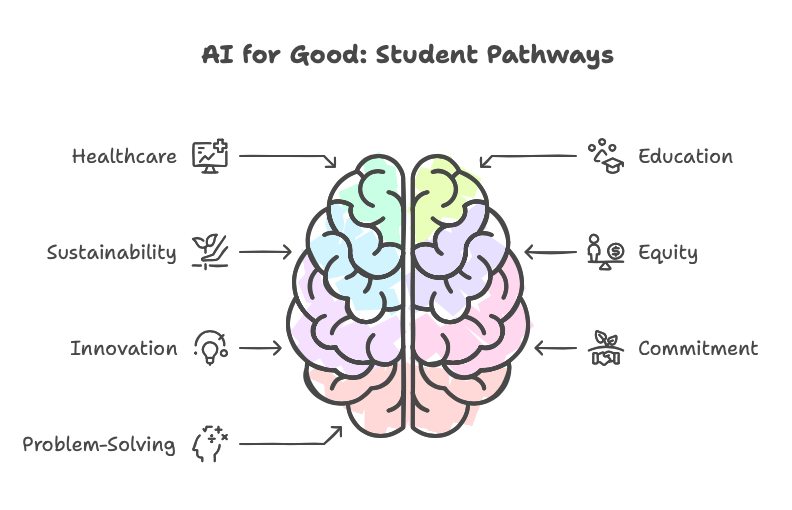- Solve for Earth.AI
- Posts
- Want to Stand Out to Colleges? This One AI Project Could Change Everything!
Want to Stand Out to Colleges? This One AI Project Could Change Everything!
Dive into how building your own "AI for Good" project can supercharge your college applications and kickstart your dream career. No coding genius required—just a passion to make a difference!
Artificial Intelligence (AI) is transforming every aspect of society, from healthcare and education to sustainability and equity. As students increasingly look to distinguish themselves in competitive academic and professional landscapes, engaging in AI for Good projects provides a remarkable opportunity to showcase innovation, commitment, and problem-solving abilities. This blog post explores how students can effectively build impactful AI for Good projects and highlights how such initiatives serve as strong differentiators for college applications and future career opportunities.

UNDERSTANDING AI for GOODAI for Good refers to projects that apply artificial intelligence technologies to solve pressing global challenges aligned with the United Nations' Sustainable Development Goals (SDGs). These projects address critical issues such as climate change, poverty alleviation, improved healthcare, educational equity, and environmental sustainability. According to a 2023 Gartner report, over 60% of global enterprises view AI as pivotal to achieving sustainability goals, underscoring the growing demand for professionals skilled in ethical and impactful AI applications. |  |
The Essentials
Steps for Building AI for Good Projects
Step 1: Identify a Meaningful Problem
Students should begin by exploring global challenges outlined by the SDGs. Popular areas include:
Climate Action (SDG 13)
Quality Education (SDG 4)
Good Health and Well-being (SDG 3)
Gender Equality (SDG 5)
Conducting thorough research to understand these issues deeply ensures projects are meaningful and impactful.
Step 2: Learn Basic AI Concepts and Tools
Mastering foundational AI skills and tools is essential. Students can start with accessible platforms and resources such as:
TensorFlow and PyTorch (for machine learning and neural networks)
Google Colab and Jupyter Notebooks (for coding environments)
Coursera, Udemy, and EdX courses (for structured learning)
Step 3: Collaborate and Network
Collaboration enhances creativity, expands knowledge, and improves project outcomes. Joining AI clubs, participating in hackathons like Microsoft's Imagine Cup or Google's Code Jam, and networking with AI professionals through LinkedIn can provide valuable mentorship and opportunities.
Step 4: Develop a Project Plan
A structured project plan should include:
Clear Objectives and Success Metrics
Timelines and Milestones
Technical Specifications
Ethical Considerations and Data Privacy
Step 5: Build and Prototype the Project
Developing a Minimum Viable Product (MVP) allows students to test their concept and demonstrate viability. Iterative prototyping, user feedback, and continuous refinement ensure real-world applicability.
Step 6: Document and Share Results
Documenting and sharing project outcomes through blogs, GitHub repositories, or platforms like Devpost provides visibility and builds credibility. Engaging storytelling and clear documentation significantly enhance project impact.
Benefits for College and Career
College Applications
Admission officers increasingly value practical, innovative projects that demonstrate intellectual curiosity and social responsibility. A survey conducted by the National Association for College Admission Counseling in 2023 indicated that nearly 80% of top-tier universities now consider project-based achievements as critical admission criteria.
An impactful AI for Good project can:
Clearly illustrate problem-solving abilities.
Showcase innovation and creativity.
Highlight leadership and collaboration skills.
Career Advantages
According to LinkedIn's Emerging Jobs Report 2024, roles involving AI ethics and sustainability witnessed a 65% growth year-over-year, signaling significant employment opportunities.
Students with experience in AI for Good projects gain:
Relevant technical and ethical AI skills.
A robust professional network.
Strong positioning for high-demand careers in technology, sustainability, and social impact.
Inspiring Examples
TrashAI: High school students developed an AI-powered system to categorize waste efficiently, helping their community significantly reduce landfill waste.
MedicAI: A college freshman created an app using machine learning algorithms to predict the onset of diabetic complications, improving healthcare accessibility in underserved areas.
Conclusion
Engaging in AI for Good projects equips students with invaluable technical skills, ethical awareness, and practical experience. Beyond differentiating students in college admissions and job markets, these projects cultivate socially responsible leaders who leverage AI to build a better, more sustainable future.
By investing time and creativity into impactful projects, students not only enhance their academic profiles but also meaningfully contribute to solving global challenges.